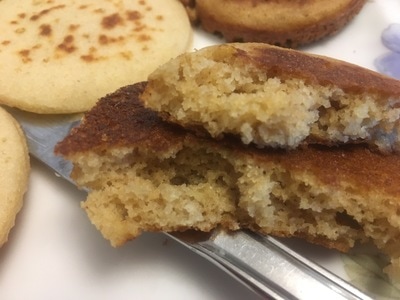 Amaranth baguettes.
Amaranth baguettes.  Second batch and third batch crumpets with a little homemade, cultured, unsalted butter.
Second batch and third batch crumpets with a little homemade, cultured, unsalted butter. So, I've been playing with ideas for making gluten free crumpets. Some months ago I made my first attempt. They were disappointing, but edible, made with a thick rice and tapioca batter; I forget the details, but I probably have notes somewhere. Since then I have been reading recipes for crumpets, thinking about how they are made with wheat, and how they might work without gluten. Some things just seem to need gluten more than others.
Then there are my own constraints: what do I want in the recipe, am I happy with lots of starch, or do I want to reduce the starches? There is an earlier question: is this to be an every day recipe or one for special occasions? If it is for special occasions, a treat, then lots of starches may be alright. Who is going to be eating it? If it is me, then milk and butter are ok, if I'm making it for my daughter, or some particular friends there will be no dairy.
What about the nutrients? If I want a quick recipe and the nutrient values are not so important it might be alright to use baking soda or bakers yeast. But if I want to make as many of the potential nutrients available as possible I'll stick to a cultured leaven: usually a sourdough cultured from rice, buckwheat, millet or quinoa, or perhaps another variation of a naturally cultured leaven. This will allow the enzymes, bacteria, and yeasts to make the flour much more digestible. Apart from these constraints, I want a product that looks, tastes and feels right.
So, back to the crumpets. I want crumpets that I can eat frequently, for breakfast or a quick lunch. I'd like to be able to make a big batch and freeze most of it for other times. So, I began with a mix of freshly milled brown rice flour and buckwheat flour. To make the most nutrients available I chose to ferment. Fermenting rice, because it is a little gritty, is better fermented for longer. To get a softer texture I used whole milk and water. The fats and proteins of the milk help with this. So, 200g freshly milled brown rice was mixed with 100g whole milk and100g water along with 50g brown rice and 50g quinoa starters. I allowed 12 hours fermentation.
At the end of the 12 hours I added a further 50g milk, 50g water, one egg (about 50g without the shell). Then I mixed 100g freshly milled buckwheat flour to the liquid, and set it aside for nearly an hour - long enough to get the buckwheat fermenting. After preparing the frying pan (a lidded chef's pan) and egg rings with a little butter (the butter I had on hand was home made, cultured butter). With the pan heated to a bit more than a medium heat, I began cooking: one large spoon of batter to each ring. I kept the heat a little lower than it might have been because I wanted the leaven to be able to work in the increasing heat, rather than kill the bacteria and yeasts too quickly. This would allow more bubbles to develop in the crumpets.
The first batch of crumpets were a little flatter than I was hoping for, so I ensured the pan was just a little hotter for the next batch. The second batch rose better, but were still not as 'holey' as I want. So, my next move was to take the remaining 1/3 of the batter and make a quick adjustment. In my reading I noticed that many recipes use yeast as well as bicarbonate of soda or baking powder. The aim is to increase the gas in the batter and create more holes in the crumpets.
The first batch were too flat, so I adjusted the temperature. I should have made a smaller first batch to get the temperature right.
The second batch were still not as good as I had hope for, but they had the right characteristics, especially the full depth holes that are the hallmark crumb of the humble crumpet.
The third batch were not crumpets! They were lovely, light, and airy. They rose well, very well. The crumb is delicate and exceptionally light. They are tasty, but not overpowering. This is the basis for an excellent large pan muffin.
What next? I'll look at adjusting the flour for the crumpets, perhaps a just a little tapioca, perhaps a slightly different rice flour to get the texture I want in a crumpet. The bicarbonate of soda may work when there is gluten to contain it, but without gluten it is not the ingredient of choice.





 RSS Feed
RSS Feed
